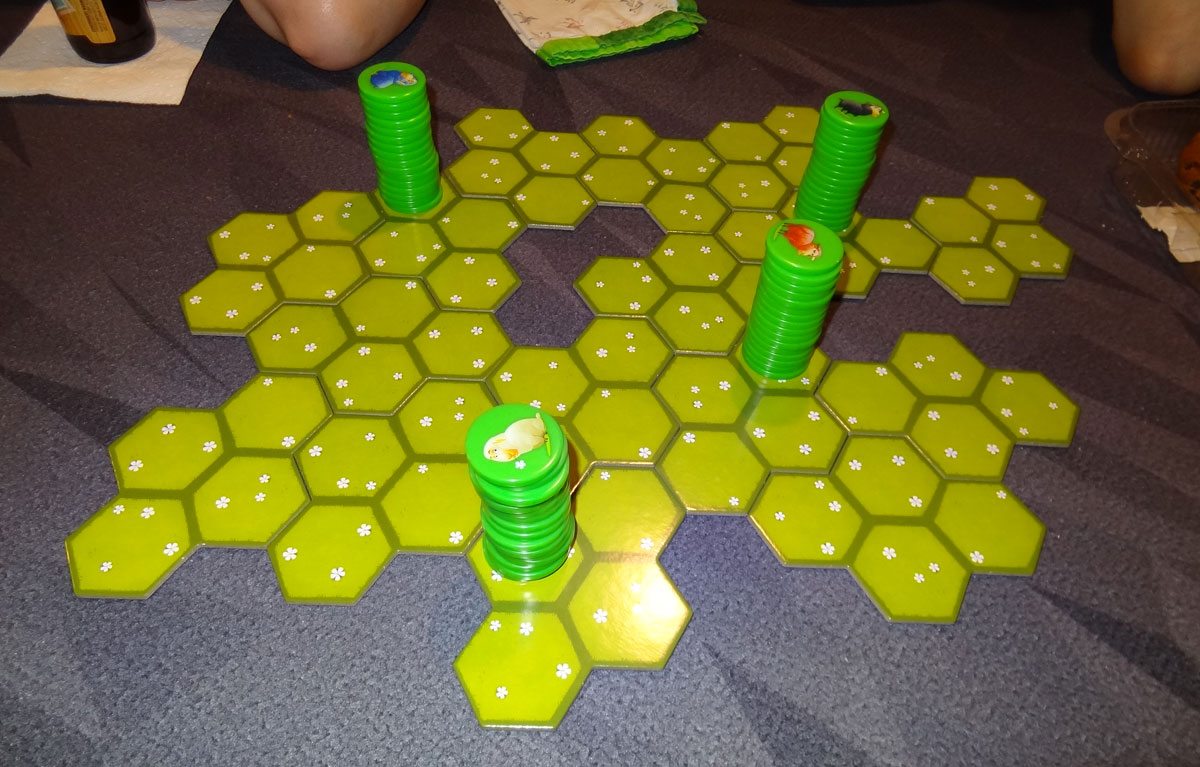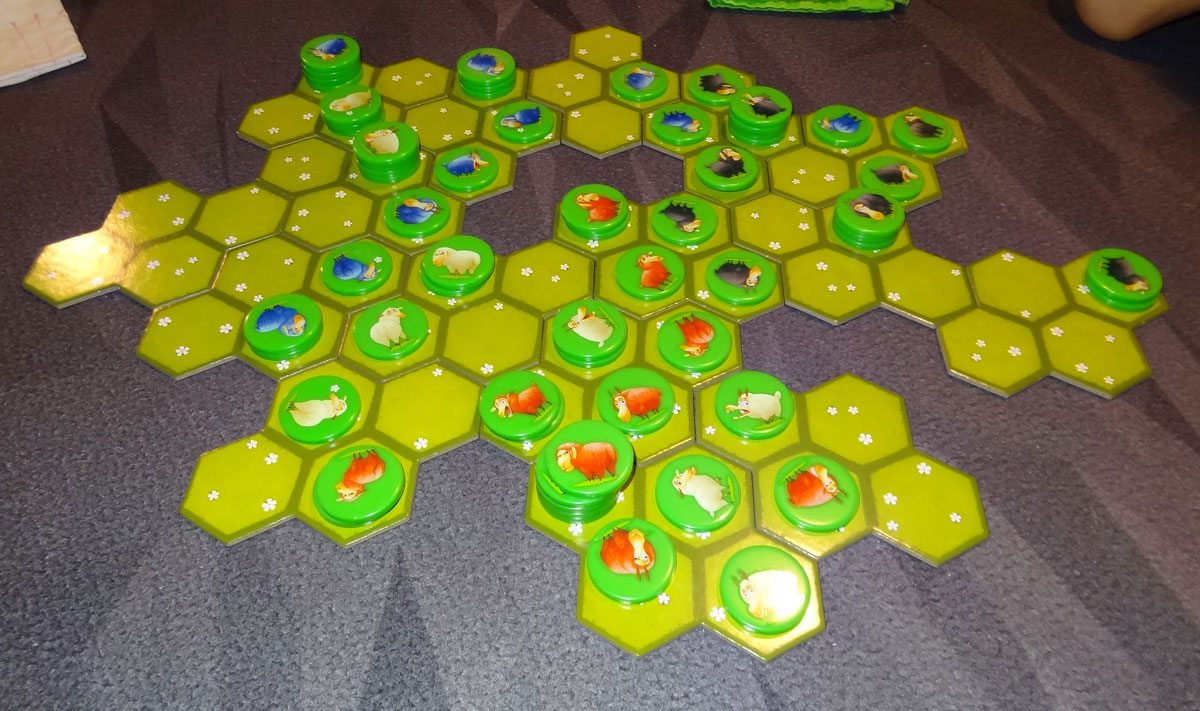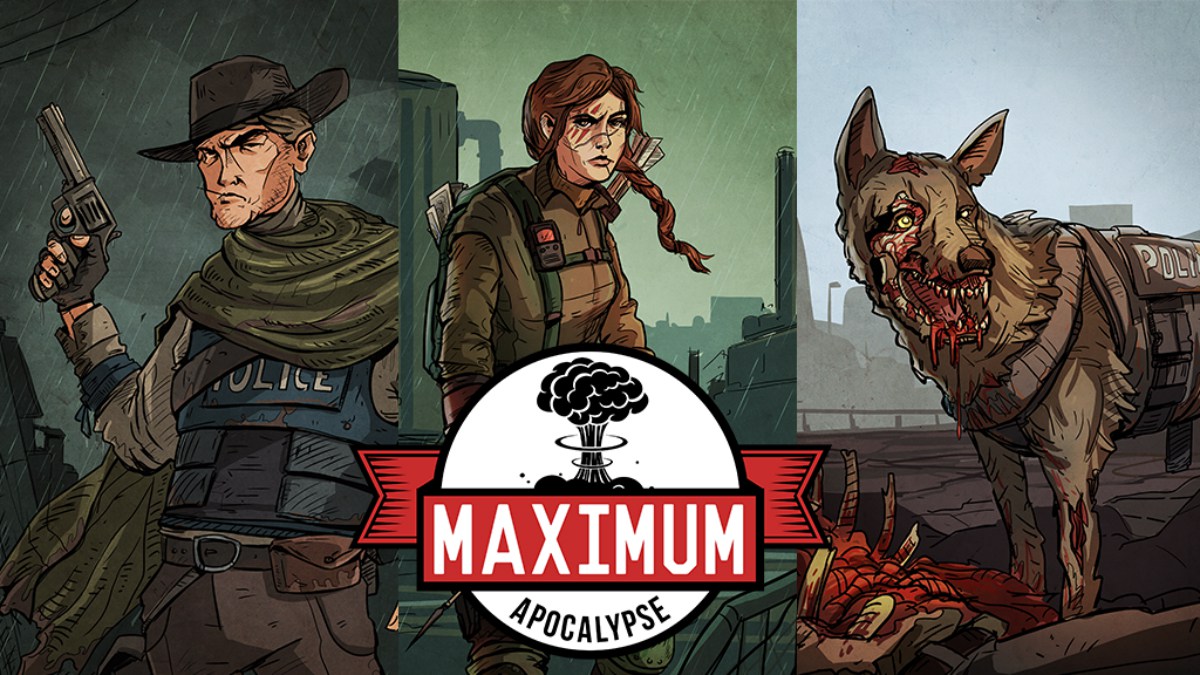Sheep just want one thing: a little patch of grass to call their own. So they’re spreading out and claiming territory, but it’s a small pasture and it’s getting crowded. Maneuver your flock into position–it’s time for Battle Sheep!
At a glance: Battle Sheep is for 2 to 4 players, ages 7 and up, and takes about 15 minutes to play. It retails for $24.99. I think the age recommendation is about right, and it’s a good one that kids and adults can play together.

Components:
- 16 Pasture Tiles
- 64 Sheep Chips (16 each in 4 colors)
The pasture tiles are cardboard tiles each made of four hexagons–perfectly serviceable, if not particularly exciting. (Then again, sheep aren’t really after excitement.)
The sheep tiles are really nice–they’re made of that bakelite plastic stuff, with “Battle Sheep” engraved on the back and images of the sheep on the front. The cartoon sheep have lots of different expressions, which is fun. The sheep tiles almost seem unnecessarily nice–like you never look at the back side of them, so they didn’t need to be engraved, but it’s a nice touch. Since you do handle the stacks of sheep throughout the game, it gives it a nice feel that you wouldn’t get with cardboard tokens.
The rulesheet is a tiny little pamphlet–I almost thought it was just a flyer for other Blue Orange Games and pitched it. The box has a nice divider that holds everything in place, and for the most part I can pick up the box and turn it over and the pieces stay where they should. You could fit all the pieces into a smaller box without the insert but they would get all jumbled.

How to play
The goal of the game is to claim as many spaces as possible in the pasture; in case of a tie, the winner is the one with the largest contiguous flock of sheep.
To set up, each player gets four of the pasture tiles, and you take turns placing them onto the table to set up a pasture. There may be holes or weird peninsulas, or you can make everything one big lump. Then, in player order, each player picks a hex on the outside perimeter and puts the whole stack of sheep there.
On your turn, you pick a stack of your sheep, split it into two stacks (at least 1 sheep in each stack, but you can split it however you want), and then move one of those stacks in a straight line until it hits either an edge or another sheep, and then drop the stack in the empty space there.

That’s basically the whole game–eventually what happens is that you get trapped, and you’ll have a stack of sheep that has nowhere to go. If you’re out of available moves on your turn, you skip your turn and wait until the game is over.
The game ends when nobody has any moves left. The player with the most pasture spaces wins, and in case of a tie the player with the largest contiguous group of sheep wins.
The Verdict
Despite the simple rules, Battle Sheep was surprisingly deep. It’s really an abstract strategy game, sheep pictures notwithstanding, and I was impressed by how much we all wanted to replay it. During Bristol-Liu Con, it was one of the first games we played, and it was a big hit. The adults played it several times before we decided we really wanted to get to some other games on our list, but the kids kept playing it again and again over the course of the week.

I really like the variable board setup–we tried lots of different shapes, and it’s not immediately obvious what the best starting position is for any given shape. We did find, however, that we usually liked making shapes with some holes or weird arms because it gave us opportunities to cut off a passage quickly.
Figuring out how to block your opponents without getting in your own way can be tricky, and is a big part of the strategy. You don’t want to send too many sheep and then get stuck with not enough space to spread them out. On the other hand, send too few and you’ll regret it when you see some space that you could reach if only you had put a few more sheep in that stack.
Battle Sheep is another one of Blue Orange Games’ “Europe Collection” titles, and I think it’s an excellent one. It works for both kids and adults (even together), it’s simple enough for kids to play on their own without help, but it has enough depth that adults can enjoy it with each other, too. The variable board shape helps to keep it new each time you play, and the excellent component quality gives the sheep chips a nice heft.
If you like abstract strategy games (or just cute cartoon sheep), put Battle Sheep on your list! Look for it at your local game store, or order a copy from Amazon.
Disclosure: I received a review copy of this game.






We love this game. We have a 10 and 7 year old and got it to play with them. Everyone understands it well, and everyone has a good chance to win. It’s a lot of fun.